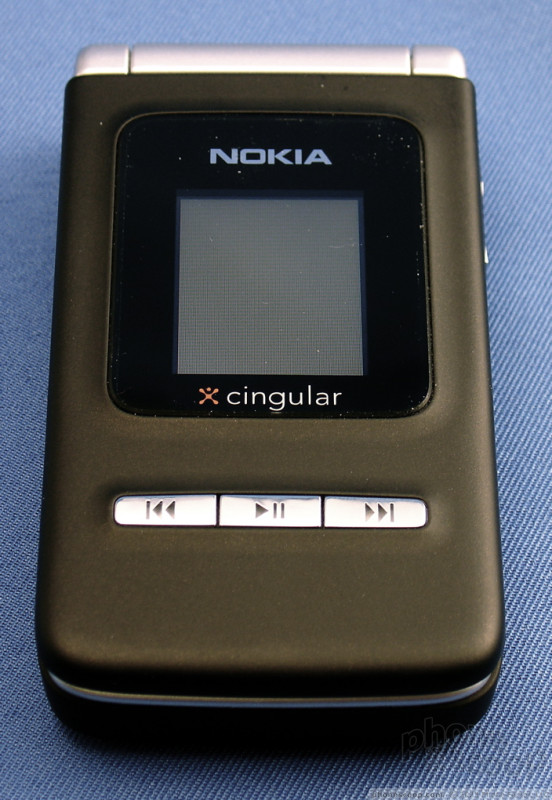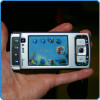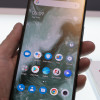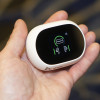Review: Nokia N75
Compared to many clamshell phones on the market, the N75 is a big honking block of mobility. Nokia has just begun to be interested in the current trend toward thinner, more pocketable products, but you wouldn't know it looking at the N75. Despite its size, the N75 is pleasing to the eye, in a functional sort of way.
Its shape is so rectangular, you can tell that its designers were aiming more for function than form. The plain design leaves you with the impression that the underlying phone is silver, but it is wrapped in a black plastic shell. The shell covers the front and back of the phone, yet leaves the silver hinge and interior surfaces "exposed". This plastic shell is textured to a degree and feels cheap. Its creaks and certain areas on the back of the phone give with just a little bit of pressure. It feels no lighter or heavier than you'd expect. Due to its girth, the N75 is hard to get your hand around. It is both wide and thick. While it doesn't rival some Nextel iDEN phones, it certainly doesn't compare to anything Samsung has released recently. You'll be fighting the battle of the bulge if you choose to store the N75 in your front pocket.
The front of the phone hosts its exterior screen and three media keys. The screen is a nice size and is surrounded in a glossy black frame that contrasts with the matte finish of the black plastic shell. The media keys are large enough to use easily and are set in a raised ridge of plastic. The smooth, silver finish sets them apart visually, and each lights up blue when the exterior screen is activated. The finish also makes them slippery, and they provide little feedback when pressed.
The buttons on the right side of the phone are also silver and illuminate with blue light when any of them are pressed. These keys are small, and recessed. Finding them with your thumb is not easy, and finding the function key in particular is downright difficult. The volume rocker is a little easier to use because it has small nubs on it.
Rather than USB, the N75 uses Nokia's proprietary POP port on the left side of the phone, and requires an adapter if you want to attach a headset or connect the N75 to a computer. This hatch was somewhat difficult to open, and we even accidentally pulled a portion of the black plastic shell away from phone. The power port and microSD hatch are found here as well. The microSD slot is easier to use than the data hatch, as there is a bigger opening for your thumbnail. Inserting and retrieving a microSD card was easy. There is no headset jack at all on the N75, you must use the POP port adapter.
The back of the N75 is where you'll find its camera lens and battery hatch. This is the cheapest aspect of the N75. The plastic of the cover is thin and chintzy feeling. Removing and replacing the cover is easy enough, but it is also easily damaged. The bottom corners of the cover have two little triangles that catch the frame of the N75 and hold the cover in place. These triangles were easily bent, preventing the cover from attaching firmly. We had to unbend them to get the cover on correctly.
Lastly, the SIM card slot is located next to the battery slot. You have to remove the battery to access it. This was one of the most difficult SIM slots we've ever used. There just isn't enough room for your fingers in the battery cavity to put the SIM in or remove the SIM easily. There is also a small, sliding pin that holds the SIM in place. You can't slide the pin and pull out the SIM with one hand. We had to resort to using tweezers to safely extract the SIM card.
Opening the N75, the hinge feels solid, and it balances well in your hand. One thing that strikes you when the N75 is open is how large the phone really is. When closed, it's only a bit shorter than a BlackBerry Pearl. Open, it dwarfs the Pearl and makes it look like a phone for an ant. The large size of the N75 provides for ample screen real estate, though. Unlike the cheap-feeling exterior, the inside of the N75 is more polished. Shiny silver accents abound.
The D-pad and control center of the N75 get poor marks from us. Because they are finished in the same glossy silver material as the media keys, the controls are slippery. You can pass your thumb all over the D-pad and not be able to tell that you've moved from one button to the next. The buttons themselves are large, though. Nokia took advantage of all the real estate available on this phone. All of the control keys and D-pad offer short action. There is a discernible click to let you know that you've pressed each button, but knowing exactly which button you pressed is hard to know unless you are looking at the phone.
Nokia made the N75's keypad as large as possible. The keys are simply gigantic. Each one is about the size of a microSD card. But there is so little texture to them, it is all too easy for your thumb to slide across the keypad and not know exactly where it is. Each key has an oval depression, but they are so shallow as to go unnoticed. As with the function keys, the number pad provides minimal action when each button is pressed. We found that due to its large size, the keypad made composing text messages and emails inefficient. Your thumb has to travel a large distance to hit each key, and this slowed us down.
As weird as it is to interact with the N75's keypad, the thing certainly looks pretty. It is far more elegant and polished than the cheaper, black-plastic exterior.

















 Nokia Open Studio Fall 2006
Nokia Open Studio Fall 2006
 iPhone 14 Plus Offers a Big Screen For Less
iPhone 14 Plus Offers a Big Screen For Less
 TCL's Newest Concept Phone has a Matte Screen
TCL's Newest Concept Phone has a Matte Screen
 Hands On with Teams-Certified Bluetooth Earbuds
Hands On with Teams-Certified Bluetooth Earbuds
 iPhone 15 Series Goes All-In on USB-C and Dynamic Island
iPhone 15 Series Goes All-In on USB-C and Dynamic Island
 Nokia N75
Nokia N75


